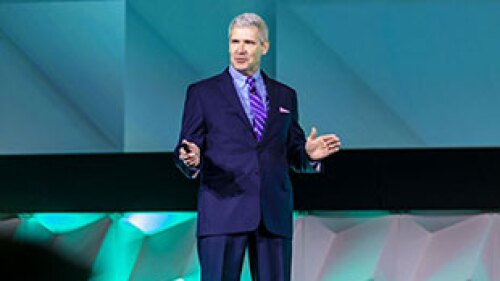Culture, amenities, and locale are vitally important in drawing in today’s modern workforce, but COVID-19 has pressed the gas pedal on workplace innovation, attendees heard at the 2020 ULI Virtual Fall Meeting session titled “Evolution of Live/Work/Play: Three Tech Campuses Vie to Be Best/Happiest Workplaces on Earth.”
“Tenants want outdoor collaborative space, they want solid food and beverage, and they want fitness and wellness,” said Matt Griffin, senior vice president of Kilroy Realty Corporation.
The session focused on three California projects at different points in the development process, including Salesforce Tower in San Francisco, Kilroy Oyster Point in South San Francisco, and Santana West in San Jose. The panelists discussed their projects, the idea of tech campuses, urban planning, and placemaking, comparing approaches and offering lessons learned from their projects.
“We first built a place that people want to go to, that people want to live at. As a result, the evolution is that we brought offices in including our newest, a 375,000-square-foot highly amenitized One Santana West ready for tenant buildout next year,” said Jan Sweetnam, executive vice president and western region chief operating officer of Federal Realty Investment Trust.
Santana West, which is part of Santana Row, is a multiphase project consisting of two sister buildings connected by a bridge, a parking garage, and a repurposed landmark building that was once a cinema theater dome. A courtyard fills the space bordered by all four structures, and expansive rooftop terraces and gardens make the space feel open and airy. The Santana Row/Santana West campus includes an integrated fitness center, full-service complementary retail space, and 30 on-site restaurants “We mixed all those things together so that we can create a street that is active from 8 o’clock in the morning until 10 p.m. at night, and now existing tenants such as Splunk, Twitter, Broadsoft and others tell us it’s a recruiting advantage,” Sweetnam said.
Key features responsive to the unanticipated market changes of the pandemic include copious outdoor upper-floor patios and outdoor courtyards, as well as extra elevators and stairways than are atypical for 8-story offices, Sweetnam said.
Robert Pester, executive vice president for the San Francisco region with Boston Properties, focused on the green and community aspects of Salesforce Tower. The building is not only certified Platinum under the Leadership in Energy and Environmental Design (LEED) rating system devised by the U.S. Green Building Council (USGBC), it also has a blackwater system, 100 percent renewable energy, a rainwater collection system, a high continuous glass line for abundant natural light, 100 percent fresh outside air delivered to every floor, and expansive 25,000-square-foot (2,300 sq m) column-free floor plates. Floors 60 and 61, which are open to the community on the weekends, have living walls, expansive views, and a full concession kitchen.
The building is also famous for its five-plus-acre (over 2 ha) living roof park, where a curved walking trail lined with benches surrounds grassy lawns, an amphitheater, fountains, and a play area for younger guests. “When they’re actually in the office building, walking around the park just having casual meetings as they’re walking around drinking their coffee, it’s pretty spectacular,” Pester said.
Alexandra Stoelzle, director of development, and Matt Griffin, senior vice president, both of Kilroy Realty Corporation, showcased Kilroy Oyster Point, which is a waterfront campus situated in a predominantly life sciences–driven part of the San Francisco Bay Area. The multi-phase campus includes 10 to 12 purpose-built buildings across four ‘neighborhoods’ totaling roughly 3 million square feet (280,000 sq m), and affording a one-of-a-kind tenant amenity package that supports wellness, sustainability, and productivity.
Kilroy brings environmentally friendly goals to its projects: it was the first real estate company in North America to commit to establishing 100 percent carbon-neutral operations by the end of 2020. Regarding how the company starts planning its projects, Stoelzle said, “Our investments team and our development team get together and evaluate the opportunities where we feel like we can create the most value for the company while also adding value to the community.”
“Our project’s strength is providing the most requested amenity, and that’s open space,” Griffin said.
However, the panelists broadly agreed that COVID-19 is affecting their projects.
Sweetnam pointed out that Federal Realty Investment Trust has smaller retail clients who are struggling in a COVID world. “We are doing everything we can on a daily basis to make sure that [our clients] have what they need if they want to fight—fight to stay alive.”
New cleaning specifications, protocols, and touchless points are now standard for all of Federal Realty Investment Trust’s office buildings, he said. “We are trying to follow the lead of what the large office use groups are doing and are trying to set up a similar protocol.”
Pester noted, “Boston Properties has a national task force for health and safety. They have been working to ensure our buildings are healthy, specifically for when people return.”
At the end of the day, Griffin said, “It’s lobby enhancements, trying to provide for dedicated entrances per building, and even sometimes multiple dedicated entrances based on how many tenants we’ve got; adding more restrooms per floor; even adding the ability to have additional stairwells. At the building level, it’s just about providing as much flexibility as you can.”


